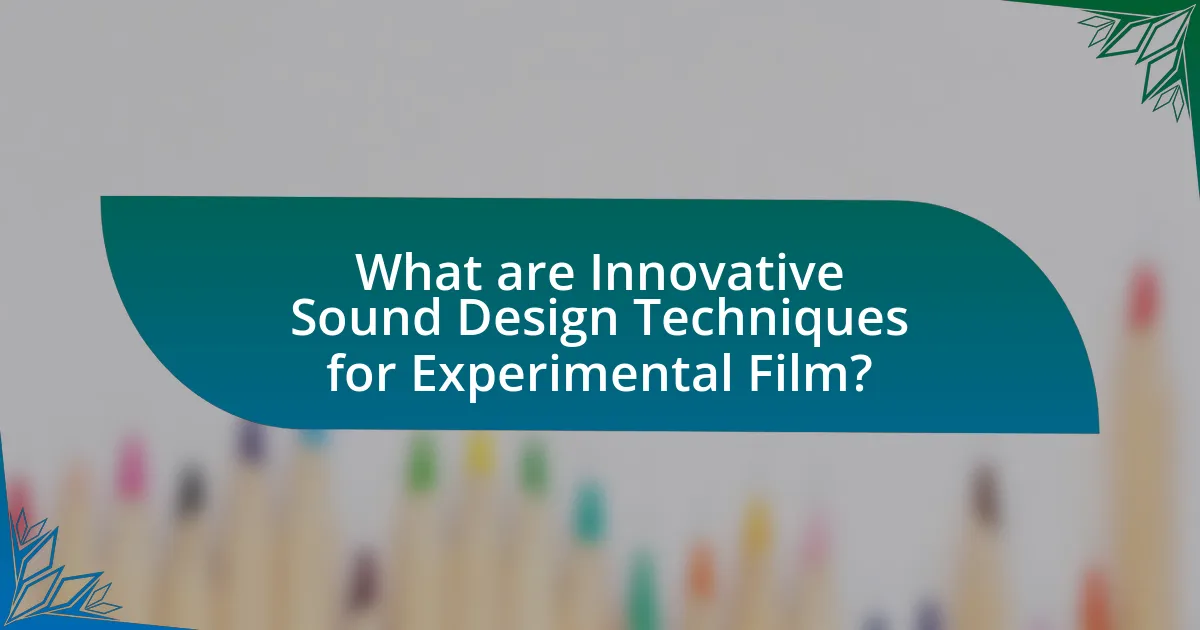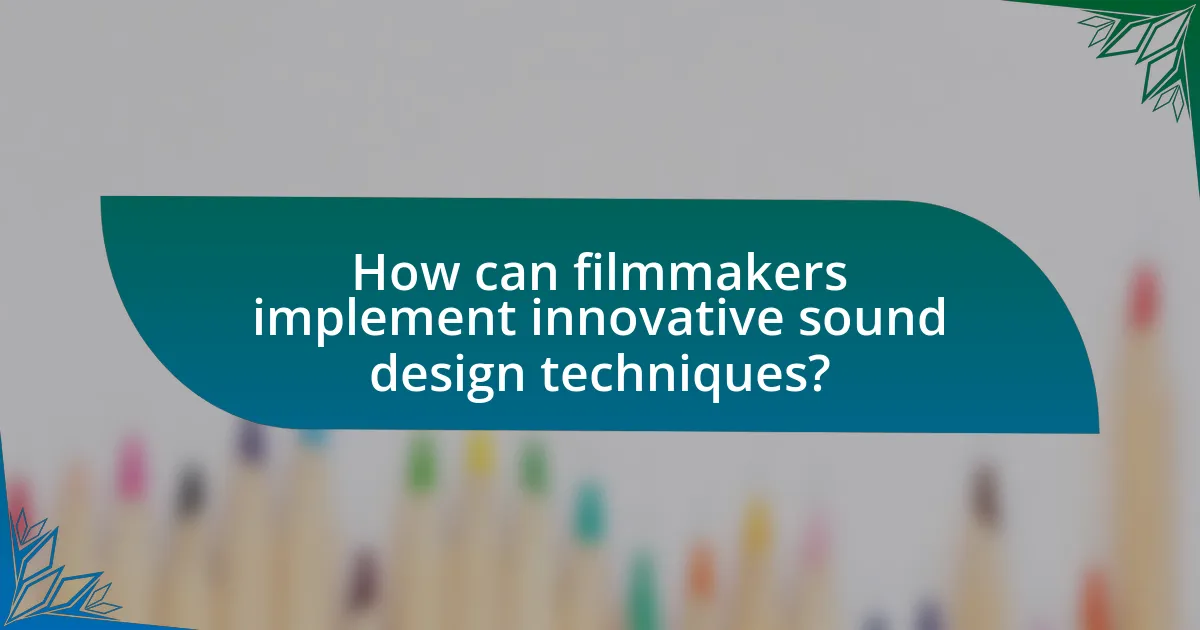Innovative sound design techniques for experimental film encompass methods such as field recordings, spatial audio, and sound manipulation through digital software. These techniques differ from traditional sound design by prioritizing creativity and abstraction over realism, allowing filmmakers to evoke emotions and concepts through unique auditory experiences. Key characteristics include the use of unconventional sound sources and immersive audio technologies, which enhance narrative engagement and emotional response. The article explores how sound influences viewer experience, the role of sound in storytelling, and practical tips for implementing innovative sound design in experimental films, while also addressing potential challenges and pitfalls filmmakers may encounter.

What are Innovative Sound Design Techniques for Experimental Film?
Innovative sound design techniques for experimental film include the use of field recordings, spatial audio, and sound manipulation through digital software. Field recordings capture real-world sounds that can create an authentic atmosphere, while spatial audio techniques enhance the immersive experience by placing sounds in a three-dimensional space, allowing viewers to perceive audio as they would in reality. Additionally, sound manipulation through software enables filmmakers to alter and layer sounds creatively, producing unique auditory experiences that complement visual storytelling. These techniques have been employed in notable works, such as “Koyaanisqatsi,” where sound design plays a crucial role in conveying themes and emotions, demonstrating their effectiveness in enhancing experimental narratives.
How do these techniques differ from traditional sound design?
Innovative sound design techniques for experimental film differ from traditional sound design primarily in their approach to creativity and experimentation. Traditional sound design typically adheres to established norms and conventions, focusing on realism and clarity to support narrative structures. In contrast, innovative techniques often prioritize abstract soundscapes, non-linear audio arrangements, and the manipulation of sound to evoke emotions or concepts rather than to represent reality. For example, while traditional sound design might use diegetic sounds that align closely with visual elements, innovative techniques may incorporate synthesized sounds or field recordings that create a surreal auditory experience, challenging the audience’s perception. This shift allows for greater artistic expression and exploration of themes, as seen in films like “Eraserhead” by David Lynch, where sound plays a crucial role in establishing mood and atmosphere beyond conventional storytelling.
What are the key characteristics of innovative sound design?
Innovative sound design is characterized by creativity, experimentation, and the integration of technology. This approach often involves the use of unconventional sound sources, such as field recordings or synthesized sounds, to create unique auditory experiences. Additionally, innovative sound design frequently employs spatial audio techniques, allowing sounds to be perceived in three-dimensional space, enhancing immersion. The use of layering and manipulation of sound elements, including pitch shifting and time stretching, further contributes to its distinctiveness. Research indicates that innovative sound design can significantly impact audience perception and emotional response, as evidenced by studies showing that well-crafted soundscapes enhance narrative engagement in experimental films.
How do experimental films utilize sound in unique ways?
Experimental films utilize sound in unique ways by employing non-traditional audio elements to enhance narrative and emotional depth. These films often incorporate ambient sounds, abstract soundscapes, and manipulated audio to create an immersive experience that challenges conventional storytelling. For instance, filmmakers like Stan Brakhage and Maya Deren have used sound to evoke feelings and ideas that are not directly tied to the visual content, thus allowing the audience to interpret the film on a more personal level. This approach can include the use of silence, dissonance, or unexpected sound juxtapositions, which serve to disrupt the viewer’s expectations and provoke thought. The innovative use of sound in experimental films often reflects the avant-garde nature of the genre, pushing the boundaries of how sound can be perceived and understood in relation to visual imagery.
Why is sound design important in experimental film?
Sound design is crucial in experimental film because it enhances the emotional and psychological impact of the visual narrative. In experimental cinema, where traditional storytelling methods may be subverted, sound design serves as a primary tool for conveying meaning, creating atmosphere, and engaging the audience’s senses. For instance, a study by the University of Southern California found that sound can significantly influence viewers’ perceptions and emotional responses, often more so than visuals alone. This underscores the importance of sound in shaping the overall experience and interpretation of experimental films.
How does sound influence the viewer’s experience?
Sound significantly influences the viewer’s experience by enhancing emotional engagement and narrative comprehension. Research indicates that sound design can evoke specific emotions, guide audience attention, and create a sense of immersion in the film’s world. For instance, a study published in the Journal of Experimental Psychology found that viewers rated films with well-crafted soundscapes as more emotionally impactful compared to those with minimal sound design. This demonstrates that sound not only complements visual elements but also shapes the overall perception and emotional response of the audience.
What role does sound play in storytelling within experimental films?
Sound plays a crucial role in storytelling within experimental films by enhancing emotional depth and creating immersive experiences. In these films, sound can convey meaning beyond visuals, often using unconventional techniques such as abstract soundscapes or manipulated audio to evoke specific feelings or ideas. For instance, the use of dissonant sounds can create tension, while harmonious tones may evoke tranquility, guiding the audience’s emotional response. This approach is supported by studies indicating that sound design significantly influences viewer perception and interpretation, as seen in works like “Koyaanisqatsi,” where the score by Philip Glass complements the visual narrative, reinforcing themes of chaos and harmony.

What are the various types of innovative sound design techniques?
Innovative sound design techniques include field recording, granular synthesis, and Foley artistry. Field recording captures real-world sounds to create an authentic auditory experience, often used in experimental films to enhance realism. Granular synthesis manipulates audio samples at a granular level, allowing for the creation of unique textures and soundscapes that can evoke specific emotions or atmospheres. Foley artistry involves the reproduction of everyday sound effects that are added to films in post-production, enhancing the narrative and immersing the audience in the film’s environment. These techniques are widely recognized in the film industry for their ability to transform the auditory experience and contribute to storytelling.
How can field recordings enhance sound design?
Field recordings enhance sound design by providing authentic, real-world audio that adds depth and realism to a project. These recordings capture unique environmental sounds, which can evoke specific emotions and create immersive experiences for the audience. For instance, a study by the University of California, Berkeley, highlights that incorporating natural sounds can significantly increase viewer engagement and emotional response in film. By integrating field recordings, sound designers can create a richer auditory landscape that complements visual storytelling, ultimately leading to a more impactful narrative.
What are the benefits of using natural sounds in film?
Using natural sounds in film enhances realism and emotional engagement. Natural sounds create an immersive environment that allows viewers to connect more deeply with the narrative. Research indicates that films utilizing authentic soundscapes can significantly increase audience immersion, as evidenced by studies showing that sound design influences emotional responses and memory retention. For instance, a study published in the Journal of Experimental Psychology found that naturalistic soundscapes improve the viewer’s ability to recall plot details, demonstrating the cognitive benefits of incorporating these elements into film.
How can field recordings be manipulated for creative effects?
Field recordings can be manipulated for creative effects through techniques such as pitch shifting, time stretching, layering, and applying effects like reverb or distortion. Pitch shifting alters the frequency of the recording, creating a different tonal quality, while time stretching changes the duration without affecting pitch, allowing for dramatic slowdowns or speed-ups. Layering involves combining multiple recordings to create a rich soundscape, enhancing depth and texture. Effects like reverb simulate acoustic environments, adding spatial characteristics, and distortion can introduce grit or intensity. These methods are widely used in sound design, as evidenced by their application in films like “Gravity,” where manipulated field recordings contribute to the immersive auditory experience.
What is the role of sound manipulation in experimental film?
Sound manipulation in experimental film serves to enhance the emotional and psychological impact of the visual narrative. By altering sound elements such as pitch, tempo, and layering, filmmakers can create a unique auditory experience that complements or contrasts with the imagery, thereby influencing audience perception and interpretation. For instance, the use of dissonant sounds can evoke feelings of tension or unease, while harmonious sounds may induce calmness. This technique is evident in works by filmmakers like David Lynch, who employs sound design to create surreal atmospheres that challenge conventional storytelling. The manipulation of sound thus plays a crucial role in shaping the overall aesthetic and thematic depth of experimental films.
How do techniques like pitch shifting and time stretching affect sound perception?
Pitch shifting and time stretching significantly alter sound perception by modifying the frequency and duration of audio signals without changing their fundamental characteristics. Pitch shifting changes the perceived pitch of a sound, which can create a sense of tension or emotional response, while time stretching alters the duration of a sound, affecting its rhythmic and temporal qualities. Research indicates that these techniques can influence listener engagement and emotional interpretation, as demonstrated in studies where altered audio tracks elicited different emotional responses compared to their original versions. For instance, a study published in the Journal of the Acoustical Society of America found that pitch alterations can lead to distinct emotional reactions, highlighting the psychological impact of these sound design techniques in experimental film.
What tools are commonly used for sound manipulation in film?
Common tools used for sound manipulation in film include digital audio workstations (DAWs) like Pro Tools, Logic Pro, and Ableton Live. These software applications allow sound designers to edit, mix, and manipulate audio tracks with precision. Additionally, plugins such as Waves, iZotope, and Soundtoys provide effects and processing capabilities that enhance sound design. Hardware tools like synthesizers, samplers, and field recorders are also integral for capturing and creating unique soundscapes. The use of these tools is supported by industry standards, as many professional studios rely on them for high-quality sound production in films.

How can filmmakers implement innovative sound design techniques?
Filmmakers can implement innovative sound design techniques by utilizing immersive audio technologies such as binaural sound and ambisonics. These techniques enhance the auditory experience by creating a three-dimensional sound environment that engages the audience more deeply. For instance, binaural recording captures sound as it would be heard by human ears, allowing for a realistic spatial audio experience when played back through headphones. Research indicates that immersive sound can significantly increase viewer engagement and emotional response, as demonstrated in studies like “The Impact of Sound on the Viewer Experience” published in the Journal of Media Psychology, which found that immersive audio enhances narrative comprehension and emotional involvement.
What are some best practices for integrating sound design in the filmmaking process?
Best practices for integrating sound design in the filmmaking process include early collaboration between sound designers and directors, utilizing sound to enhance storytelling, and conducting thorough sound research. Early collaboration ensures that sound design aligns with the film’s vision, as evidenced by films like “A Quiet Place,” where sound was integral to the narrative. Utilizing sound to enhance storytelling involves creating an emotional landscape that complements visuals, supported by studies showing that sound significantly impacts audience perception and engagement. Conducting thorough sound research, including location sound and sound effects, ensures authenticity and depth, as demonstrated in documentaries where accurate soundscapes enhance realism.
How can collaboration with sound designers enhance the film’s audio landscape?
Collaboration with sound designers enhances a film’s audio landscape by integrating specialized expertise that elevates the overall auditory experience. Sound designers possess the skills to create unique soundscapes, manipulate audio elements, and develop sound effects that align with the film’s narrative and emotional tone. For instance, a study by the University of Southern California found that films with well-crafted sound design can increase audience engagement by up to 30%, demonstrating the significant impact of sound on viewer perception. This collaboration allows filmmakers to explore innovative techniques, such as spatial audio and immersive sound environments, which can transform the storytelling experience and deepen audience immersion.
What steps should filmmakers take to ensure sound complements visuals?
Filmmakers should conduct thorough sound design planning to ensure sound complements visuals effectively. This involves collaborating closely with sound designers during pre-production to align audio elements with the visual narrative. Filmmakers should also utilize sound editing techniques, such as layering ambient sounds and using diegetic sound to enhance the realism of scenes. Additionally, they should conduct sound tests during filming to ensure audio quality matches the visual aesthetics. Research indicates that sound significantly influences audience perception and emotional response, as demonstrated in studies showing that well-synchronized sound and visuals can enhance viewer engagement and storytelling effectiveness.
What challenges might filmmakers face when using innovative sound design?
Filmmakers may face several challenges when using innovative sound design, including technical limitations, audience perception, and integration with visual elements. Technical limitations can arise from the need for specialized equipment and software, which may not be readily available or may require extensive training to use effectively. Audience perception poses a challenge as innovative sound design can sometimes be perceived as distracting or confusing, potentially detracting from the narrative. Additionally, integrating innovative sound design with visual elements can be complex, as filmmakers must ensure that the sound complements rather than overwhelms the visuals, maintaining a cohesive storytelling experience.
How can filmmakers overcome technical limitations in sound design?
Filmmakers can overcome technical limitations in sound design by utilizing advanced digital audio workstations (DAWs) and employing creative sound manipulation techniques. These tools allow for the layering of sounds, real-time editing, and the application of various effects, which can enhance the auditory experience even with limited resources. For instance, software like Pro Tools or Ableton Live enables filmmakers to create complex soundscapes by combining recorded sounds with synthesized audio, thus compensating for hardware constraints. Additionally, filmmakers can leverage field recordings and Foley techniques to generate unique sound elements that enrich the film’s atmosphere, demonstrating that innovative approaches can effectively address technical challenges in sound design.
What common pitfalls should be avoided in experimental sound design?
Common pitfalls to avoid in experimental sound design include neglecting the relationship between sound and visuals, overcomplicating sound layers, and failing to consider the emotional impact of sound. Neglecting the relationship can lead to disjointed experiences, as sound should enhance the visual narrative rather than distract from it. Overcomplicating sound layers may result in muddled audio that confuses the audience, as clarity is essential for effective communication. Lastly, failing to consider the emotional impact can diminish the intended effect of the film, as sound plays a crucial role in evoking feelings and guiding audience reactions.
What practical tips can enhance innovative sound design in experimental films?
To enhance innovative sound design in experimental films, filmmakers should explore unconventional sound sources and techniques. Utilizing everyday objects as instruments can create unique auditory experiences, as demonstrated by filmmakers like David Lynch, who often incorporates non-traditional sounds to evoke emotion and atmosphere. Additionally, layering sounds in unexpected ways can produce rich textures; for instance, combining natural sounds with electronic elements can create a surreal soundscape. Employing spatial audio techniques, such as binaural recording, can immerse the audience further, as research shows that spatial audio enhances emotional engagement in film. Lastly, experimenting with sound manipulation tools, like granular synthesis, allows for the transformation of familiar sounds into something entirely new, fostering creativity and innovation in sound design.


